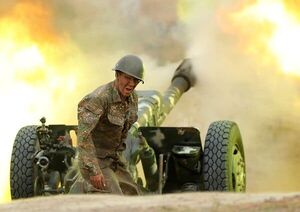Alpachnee War
The Alpachnee War was a military conflict between the Republic of Corumm and the Kiravian Federacy against the Alpachnee Confederation. There are various factors for the start of hostilities chief among them the confederation's advantageous geographic location, possessing extensive coasts in both the Nysdra Sea and the Albion Sea, the country's important mineral reserves and its military weakness. The attacking powers invaded without any mandate of the League of Nations's Security Council, ignoring any outrage from other states. The Alpachnee Confederation was overrun in little over three months and its territory was partitioned between the victors.
| Alpachnee War | |||||||
|---|---|---|---|---|---|---|---|
| Part of The Deluge | |||||||
 Kirav boy getting his eardrums blown up | |||||||
| |||||||
| Belligerents | |||||||
| Commanders and leaders | |||||||
Background
Like many native Cronite states, the Alpachnee Confederation, which occupied much of northwestern Crona, was a weak state that had long struggled to balance the competing interests of its many different resident ethnic groups, develop strong political institutions, or sustain reliable economic growth. As the states around the confederation were dismantled and replaced with colonial rumps, Alpachnee elites at first adopted a conciliatory tone to avoid the same fate. However these attempts were rebuffed, with the confederation's territory already being divvied up in secret talks between Kiravia and Corumm. Alpachnee's entry into the NSTA was torpedoed by Corummese diplomacy to prevent it from invoking the organization's mutual defense clause. Alpachnee's diplomatic attempts to gain international attention of its plight at the League of Nations went mostly ignored, with Corummese representative Shang Tsung mockingly calling them 'the last pathetic mewling of a terrorist state'. On the 15th of September the Corummese announced a blockade of Alpachnee's western coast ostensibly to combat drug and weapons smuggling. Three days later the Kiravians did the same on the eastern coast.
The Corumm-Kiravia compact used the presence of transnational revolutionary movements as a formal excuse to declare war. After the debellation of Nanseetucket and the establishment of Corummese and Kiravian colonial administrations on its former territory, some forces loyal to the old regime took refuge in Alpachnee lands, as did anti-colonial militant groups such as the Revolutionary Guerrilla Triads - Eastern Command.
Outbreak
Hostilities broke on October 31st 2020 after an Alpachnee aircraft supposedly violated Corummese airspace and was brought down by air defenses. Corumm responded shortly after by striking several Alpachnee military sites with unmanned drones and artillery strikes on border posts. A few hours later the Corummese Army of Conquest and auxiliary units from the Peace Brigade began a wholescale offensive into Alpachnee; dubbed Operation Spring Clean.
Corummese operations
Corummese forces faced only weak resistance on its advance on the regional capital as the majority of local forces retreated into Tarum and made it the lynchpin of Alpachnee's southwest defense. Alpachnee reinforcements streaming south from Umuto ballooned the city's defenders to around 10,000. Crucially for the defense, Alpachnee had in its posession very few anti air systems, mostly older Pelaxian models. During the siege these would prove completely unable to shoot down Corummese drones which picked apart artillery emplacements, troop convoys and strategically important buildings. By November 6th Corummese forces had broken through defensive lines east and west of the city and were close to encircling it. Only the highway north to the city of Umuto remained open and was the defender's last line of communication and supply with the rest of Alpachnee controlled territory. By november 7th the Tarum-Umuto highway was within range of Corummese artillery. An Alpachnee counterattack managed to recover five villages east of the highway before being repelled back. On November 8th and under LoN auspices, Corummese and Alpachnee commanders agreed to set up a humanitarian corridor to allow Tarum's remaining defenders to leave the city while abandoning all of their ammunition, vehicles and heavy weaponry.